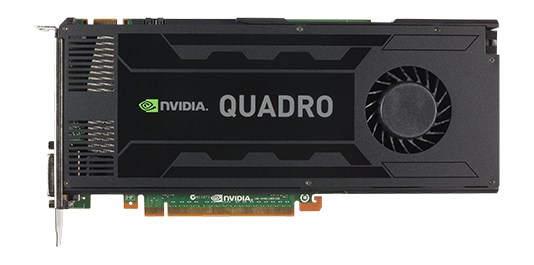Nvidia Launches Quadro Refresh, Brings Kepler To the Midrange Workstation Market
For nearly three years, Nvidia's Quadro line has relied on GF100 hardware. These cards, based on the original Fermi / GTX 480 architecture, have grown increasingly long in the tooth. NV launched new high-end parts a year ago, with the K6000 and K5000, but left the other cards mostly alone. Today, that changes. The Quadro K4000, K2000, 2000D (the same card, but with dual-DVI instead of DVI + DisplayPort, and K600 are the new entrants in the Quadro line, replacing the 4000, 2000, and 600 respectively.
The upgrades are significant. The K4000 is a 768-core GPU with 3GB of DDR5 and an 80W TDP, as compared to the vanilla 4000 with 256 cores, 2GB of RAM, and a 142W TDP. The K2000 moves to 384 cores (up from 192) and 2GB of RAM (up from 1GB) with a 51W TDP instead of the 2000's 62W. Finally the K600 uses 192 cores and 1GB of DDR3, as compared to the 600's 96 cores and 1GB of RAM. Given the performance efficiency differences between Fermi and Kepler, it's impossible to say how much of a performance gain these cards offer -- but Fermi wasn't an efficiency champ in performance or performance per watt.

The K2000D (above) and K2000
Nvidia states that these cards can give a 50% performance boost in some workloads, which doesn't seem unreasonable. The K4000 will run $1299, the K2000/K2000D is $599, while the K600 is $199.

The Quadro K4000
AMD sent over an email to emphasize its competitive positioning relative to the new cards, and it's true -- the W7000, W5000, and V4900 are substantially more powerful on paper.

Whether these capabilities would translate to real-world performance gains simply isn't clear right now. The AMD cards are certainly cheaper, but the W9000 and W8000 were far faster than the old Quadro 6000 on paper, too. In real world tests, they struggled to match NV's much older GPU. Looking at these stats, we suspect the V4900 would win over K600 thanks to the use of GDDR5 and 2.5x as many GPU cores, but we'd have to run the numbers to verify if the W7000 and W5000 are good values in absolute terms.
For those of you who want workstation-class features and support and are less concerned about speed, the price/performance ratio on AMD's FirePro hardware should keep them competitive -- but NV's move to Kepler will be hailed as a nice boost for the performance per watt and raw performance of the Quadro line.
The upgrades are significant. The K4000 is a 768-core GPU with 3GB of DDR5 and an 80W TDP, as compared to the vanilla 4000 with 256 cores, 2GB of RAM, and a 142W TDP. The K2000 moves to 384 cores (up from 192) and 2GB of RAM (up from 1GB) with a 51W TDP instead of the 2000's 62W. Finally the K600 uses 192 cores and 1GB of DDR3, as compared to the 600's 96 cores and 1GB of RAM. Given the performance efficiency differences between Fermi and Kepler, it's impossible to say how much of a performance gain these cards offer -- but Fermi wasn't an efficiency champ in performance or performance per watt.

The K2000D (above) and K2000
Nvidia states that these cards can give a 50% performance boost in some workloads, which doesn't seem unreasonable. The K4000 will run $1299, the K2000/K2000D is $599, while the K600 is $199.

The Quadro K4000
AMD sent over an email to emphasize its competitive positioning relative to the new cards, and it's true -- the W7000, W5000, and V4900 are substantially more powerful on paper.

Whether these capabilities would translate to real-world performance gains simply isn't clear right now. The AMD cards are certainly cheaper, but the W9000 and W8000 were far faster than the old Quadro 6000 on paper, too. In real world tests, they struggled to match NV's much older GPU. Looking at these stats, we suspect the V4900 would win over K600 thanks to the use of GDDR5 and 2.5x as many GPU cores, but we'd have to run the numbers to verify if the W7000 and W5000 are good values in absolute terms.
For those of you who want workstation-class features and support and are less concerned about speed, the price/performance ratio on AMD's FirePro hardware should keep them competitive -- but NV's move to Kepler will be hailed as a nice boost for the performance per watt and raw performance of the Quadro line.

